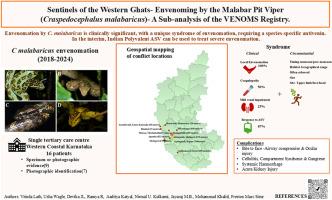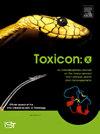Sentinels of the Western Ghats- envenoming by the Malabar pit viper (Craspedocephalus malabaricus)-A sub-analysis of the VENOMS registry
IF 2.8
Q2 TOXICOLOGY
引用次数: 0
Abstract
Background
Malabar Pit Viper (Craspedocephalus malabaricus), endemic to the Western Ghats of India, is an emerging concern in snakebite envenomation. Despite its increasing recognition as a medically significant species, the absence of a species-specific antivenom and limited epidemiological data hinder effective treatment protocols. This study examines the ecological, clinical, and therapeutic aspects of Malabar pit viper envenomation to bridge knowledge gaps and guide clinical management.
Methodology/principal findings
A retrospective analysis was conducted at a tertiary care centre in Coastal Karnataka, encompassing 16 cases from May 2018 to March 2024. Identification was based on the following method.
• killed or live specimen produced at the hospital.
• photographic/videographic evidence captured of the culprit snake by the patient or witness.
• photographic identification (using standard images of known venomous snakes in the region for patients to identify which snakes it is that they saw biting them).
Seven out of sixteen cases were identified based on photographic identification and other circumstantial evidence like snake description, location and habitat where the patient was bitten. These cases were included on a presumed basis due to the lower quality of evidence available. The remaining nine were reliably confirmed with evidence provided. Clinical presentations included severe local envenomation (100 %), coagulopathy (50 %), and mild renal dysfunction (25 %). Local complications such as severe local effects and compartment syndrome necessitated interventions. A notable trend of prolonged prothrombin time derangement, persisting up to 72 h, was observed in patients with coagulopathy. Additionally, three cases of anaphylaxis were reported following Indian Polyvalent Anti Snake Venom (ASV) administration, underscoring the challenges in its use. Indian Polyvalent ASV demonstrated limited but observable cross-reactivity, improving coagulopathy in some cases. The study identified seasonal and occupational risk factors, with most incidents occurring during monsoon-related agricultural activities. Epidemiological mapping highlighted habitat overlaps between human populations and the species range.
Conclusions/Significance
Malabar Pit Viper envenomation is characterized by distinct local and systemic syndromes, requiring targeted management strategies. While Indian Polyvalent ASV may offer interim relief in severe cases, a species-specific antivenom remains essential. This study emphasizes the importance of advancing research into venom composition, therapeutic cross-reactivity, and regional incidence to develop evidence-based treatment protocols and improve patient outcomes.

西高止山脉的哨兵——马拉巴尔蝮蛇(Craspedocephalus malabaricus)的入侵——对VENOMS登记的亚分析
malabar蝮蛇(Craspedocephalus malabaricus)是印度西高止山脉特有的毒蛇,是一种新兴的蛇咬中毒问题。尽管它作为一种医学上重要的物种越来越受到认可,但缺乏一种特定物种的抗蛇毒血清和有限的流行病学数据阻碍了有效的治疗方案。本研究检视马拉巴蝮蛇中毒的生态、临床和治疗方面,以弥合知识差距和指导临床管理。回顾性分析在卡纳塔克邦沿海的一家三级医疗中心进行,包括2018年5月至2024年3月的16例病例。鉴定方法如下:•在医院生产的死的或活的标本。•病人或证人拍摄到的蛇的照片/录像证据。•照片识别(使用该地区已知毒蛇的标准图像,以便患者识别他们看到的是哪条蛇咬他们)。16例中有7例是根据照片识别和其他间接证据(如蛇的描述、患者被咬的位置和栖息地)确定的。由于可获得的证据质量较低,这些病例是在假定的基础上纳入的。其余9项已根据提供的证据得到可靠证实。临床表现包括严重的局部中毒(100%),凝血功能障碍(50%)和轻度肾功能障碍(25%)。局部并发症如严重的局部效应和筋膜室综合征需要干预。凝血功能障碍患者凝血酶原时间紊乱明显延长,持续时间长达72小时。此外,在印度多价抗蛇毒(ASV)施用后报告了3例过敏反应,强调了其使用中的挑战。印度多价ASV表现出有限但可观察到的交叉反应性,在某些情况下可改善凝血功能。该研究确定了季节性和职业风险因素,其中大多数事件发生在与季风有关的农业活动期间。流行病学制图强调了人类种群和物种范围之间的栖息地重叠。结论/意义阿拉巴马蝮蛇中毒具有明显的局部和全身症状,需要有针对性的治疗策略。虽然印度多价ASV可能在严重病例中提供暂时缓解,但物种特异性抗蛇毒血清仍然是必不可少的。本研究强调了推进毒液成分、治疗交叉反应性和区域发病率研究的重要性,以制定循证治疗方案并改善患者预后。
本文章由计算机程序翻译,如有差异,请以英文原文为准。
求助全文
约1分钟内获得全文
求助全文
来源期刊

Toxicon: X
Pharmacology, Toxicology and Pharmaceutics-Toxicology
CiteScore
6.50
自引率
0.00%
发文量
33
审稿时长
14 weeks
 求助内容:
求助内容: 应助结果提醒方式:
应助结果提醒方式:


